Temple Treasures
■ Stone Table
Zuioji has 13 stone tablets, which are considered to be the greatest number of stone tablets a temple has in this ward (Adachi-ku, Tokyo). Amongthem there are two dual tablets, which are all of the kind that have been found so far inthis ward. Out of the Temple's 13 stone tablets, nine are explained below from various angles.The remaining four are not so good as the nine in shape and other aspects, and their origins are unknown.
【1】
 Christian Era/1449
Christian Era/1449
Date & Era/June 5, First year of Hotoku
Main Buddha/Amida
Text & Dedicator/Master Keiho
Size/length63×width16
Perfect or Chipped/Perfect
Remarks/Amida and His Two Attendants
This tablet remains in perfect shape and shows Sanskrit letters representing Amida and his two attendants. Such letters are called shuji or seed-letters. The triangle head of the tablet also remains in almost perfect shape, and its two horizontal lines are carved deep. The Sanskrit letter representing Amida in the line engraving of a moon ring looks beautiful and powerful. The lotus pedestal supporting this letter is carved well. The Sanskrit letters representing Amida's two attendant bodhisattvas, Kannon and Seishi, have no lotus pedestals, but their carving is of excellent quality. At the lower right of the Sanskrit letters there is an inscription of year reading "First year of Hotoku, Year of the Serpent" (1449), and at the lower left there is another inscription of month and date reading "June 5." The characters inscribed in the center, which read "Keiho Ajari" (Master Keiho), remain in legible condition. The tablet has no frame lines and, with no chips on the periphery, remains in perfect shape. The first year of the Hotoku era (1449) was in the reign of Emperor Go-Hanazono and under the government of Shogun Ashikaga Yoshimasa in the Muromachi period.
【2】
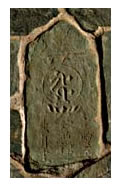 Christian Era/1471
Christian Era/1471
Date & Era/Nov. 12, 3rd year of Bunmei
Main Buddha/Amida
Text & Dedicator/Nun Myosai
Size/length30×width14
Perfect or Chipped/Basal part chipped
Remarks/-
This tablet has a small chip at the right end of its triangle head, but its two thick horizontal lines remain clear. The moon ring round the Sanskrit letter is line-engraved well, and the Sanskrit letter representing Amida is finely carved in yagen-bori, a carving method in which each line is cut or carved so that its section is V-shaped. The lotus pedestal below the letter is good-shaped and carved well. The month and date carved on the right side clearly read "November 12." The Buddhist name engraved thereon is also legible as "Myosai Zenni" (Nun Myosai). The basal part is chipped a little. A frame line is recognizable on the left edge. Its year, the third year of Bunmei (1471), was in the reign of Emperor Tsuchimikado and under the government of Shogun Ashikaga Yoshimasa when Higashiyama culture flourished.
【3】
 Christian Era/1289
Christian Era/1289
Date & Era/Aug., 2nd year of Shoo
Main Buddha/Amida
Text & Dedicator/-
Size/length65×width26
Perfect or Chipped/Basal part chipped
Remarks/-
This tablet shows a Sanskrit letter representing Amida alone. The triangle head has no chips, and its two horizontal lines remain clear. The tablet's forehead just below the horizontal lines shows no trace of corrosion. The Sanskrit letter is engraved in yagen-bori and looks powerful. Its lotus pedestal is also carved well. An ovary in the middle position (hereinafter referred to as "a middle ovary") is recognizable in the lotus pedestal, and its numerous petals are carved well. The inscription of date below the lotus pedestal reads "a Day in August, Second year of Shoo" (1289). The kanji characters of the year and month are written in s冱ho (a highly cursive style of calligraphy). Carved frame lines are seen on the four sides. The basal part is chipped a little at its lower right. This tablet is the oldest in this ward (Adachi-ku, Tokyo). August 1289 was in the reign of Emperor Fushimi in the Kamakura period.
【4】
 Christian Era/1362
Christian Era/1362
Date & Era/Oct., 2nd year of Koan
Main Buddha/Amida
Text & Dedicator/-
Size/length44×width14
Perfect or Chipped/Perfect
Remarks/-
This tablet is small in size and remains in perfect shape. Its triangle head has no chips, and the two horizontal lines are comparatively thick and clear. The Sanskrit letter representing Amida is engraved in yagen-bori and looks beautiful and powerful. The lotus pedestal is carved well, and a middle ovary is also seen vaguely there. The inscription of date reads "Second year of Koan" (1362), which are engraved on the right, and "a Day in October," which are engraved on the left. A significant feature of this tablet is that it has a flower vase below the inscription of date. The vase is about fourcentimeters or 1.6 inches high, and two belt-like lines are carved on its body. The neck of the vase is rather thick, measuring about one centimeter or 0.4 inch across. The lotus flower in the vase is about 3.5 centimeters or 1.38 inches high, the left lotus leaf about 2.5 centimeters or one inch high, and the right lotus leaf about two centimeters or 0.79 inch high. Stone tablets with such flower vase designs are very rare among those in this ward. This tablet is consequently very precious. The date is "a Day in October, Second year of Koan" (1362). The era name was changed to Joji effective September 23, 1362. The year corresponds with the 17th year of Shohei in the Southern Court (the period of the Northern and Southern Courts lasted from 1337 to 1392). That is, it was an age of opposition between Emperor Go-Murakami of the Southern Court and Emperor Go-Kogon of the Northern Court. It was really an age of disorder when the shogun of the time, Ashikaga Yoshiakira, ran here, there and everywhere to hunt down and kill insurgent troops. Unlike the modern times, communication media was undeveloped in those days, and that must be why the old era name, Koan, was still used even in October 1362 when the era name had already been changed to Joji. Thus this tablet reflects an aspect of the social conditions of the times.
【5】
 Christian Era/1361
Christian Era/1361
Date & Era/May 25, 6th year of Enbun
Main Buddha/Amida
Text & Dedicator/-
Size/length55×width23
Perfect or Chipped/Upper part chipped
Remarks/-
his tablet shows a Sanskrit letter representing Amida alone. Unfortunately, its triangle head is chipped. The Sanskrit letter is engraved in yagen-bori, and part of the letter is surrounded by a moon ring. What is considered to be a middle ovary is recognizable as a part of the lotus pedestal. The inscription of date reads "Sixth year of Enbun" (1361) on the left and "May 25" on the right with a flower vase design in-between. The flower vase is about five centimeters or 1.6 inches high, and two belt-like lines are carved on its body. Its neck is rather narrow, and the flowers in it are defaced and not recognizable. The carved frame lines remain clear except at the lower right edge. It is a pity for the right edge of the basal part and the top of the Sanskrit letter to have been chipped. The sixth year of the Enbun era is 1361 in the Christian era and the 16th year of the Shohei era according to the Southern Court's calendar. In the Northern Court, the era name was changed to Koan effective March 29, 1361, so May 25 of the sixth year of Enbun should be May 25 of the first year of Koan. The year was in the reign of Emperor Go-Kogon of the Northern Court and in the reign of Emperor Go-Murakami of the Southern Court. It was around the time when Ashikaga Yoshiakira succeeded his father Takauji and became the second shogun of the Muromachi period. It could not be helped owing to undeveloped communication media in those days, but it is felt strange for us that the old era name was still used here in the province of Bush* (mainly present-day Tokyo and Saitama Prefecture) even two months after the change of the era. This is also considered to reflect an aspect of the social conditions of the times.
【6】
 Christian Era/1426
Christian Era/1426
Date & Era/Nov. 8, 33rd year of oei
Main Buddha/Amida
Text & Dedicator/Performance of a Buddhist service in advance to pray for the repose of my soul - Kyojitsu
Size/length41×width15
Perfect or Chipped/Perfect
Remarks/-
This tablet is small in size and shows a Sanskrit letter representing Amida alone. The triangle head remains in almost perfect shape, and its two horizontal lines are thick and clear. The tablet's forehead is not worn out, and the carved frame lines, though narrow, remain clear. The Sanskrit letter and its lotus pedestal are carved well and look beautiful. The inscription of date reads "Thirty-third year of ・i" (1426) on the right and "November 8" on the left. Carved in the center are four kanji characters meaning "Performance of a Buddhist service in advance to pray for the repose of my soul - Kyojitsu." A pious person by the name of Kyojitsu must have held a Buddhist service before his death to earnestly pray for his easy passage into the Pure Land of Utmost Bliss. This tablet, though small in size, is preserved in perfect shape. The thirty-third year of the oei era was in the reign of Emperor Shoko. The Northern and Southern Courts reconciled, and the Meitoku era of the Northern Court and the Genchu era of the Southern Court were unified into oei. This tablet is a witness of the time.
【7】
 Christian Era/1441
Christian Era/1441
Date & Era/Feb. 23, 13th year of Eikyo
Main Buddha/Amida
Text & Dedicator/Nun Honjo - Performance of a Buddhist service in advance to pray for the repose of my soul
Size/length40×width16
Perfect or Chipped/Basal part chipped
Remarks/-
his tablet is small in size and shows a Sanskrit letter representing Amida alone. The triangle head remains in almost perfect shape, and its two horizontal carved lines are clear. The forehead has no major chips. The Sanskrit letter is engraved in yagen-bori and good-shaped. The lotus pedestal is also carved well in good form and looks beautiful. Carved below the lotus pedestal are six kanji characters meaning "Nun Honjo - Performance of a Buddhist service in advance to pray for the repose of my soul." A pious woman called Nun Honjo must have held a Buddhist service for her before her death and dedicated this tablet. The inscription of date reads "Thirteenth year of Eikyo" (1441) on the right and "February 23" on the left. It is a pity for the basal part to have been chipped at its lower right edge. February 23, 1441, was in the reign of Emperor Go-Hanazono and under the government of Shogun Ashikaga Yoshinori.
【8】
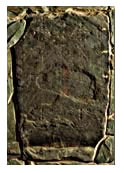 Christian Era/-
Christian Era/-
Date & Era/-
Main Buddha/Buddha Shakamuni・Amida
Text & Dedicator/-
Size/length66×width104
Perfect or Chipped/Upper and lower parts chipped
Remarks/Dual tablet
This is a dual tablet, which is very rare in this ward (Adachi-ku, Tokyo). It must be the largest tablet in this ward, measuring 66 centimeters or 2.17 feet high and 104 centimeters or 3.4 feet across. Its upper center is chipped in the form of a concave, and the tops of both ends are rounded and slightly protruding. The right edge is somewhat uneven, while the left edge is comparatively smooth, although its central part protrudes. The lower part is rounded and unfortunately chipped off below the Sanskrit letter. The tablet, if not chipped off, would be a wonderful piece indeed. The frame lines are neatly carved from the top down on both ends in a width of one centimeter or 0.4 inch. The length from the center line to the right and left frame lines is 41 centimeters or 1.35 feet respectively. Five buddhas in esoteric Buddhism appear to be represented by Sanskrit letters at the forehead of the right tablet, and below each letter there is a lotus pedestal with 10 petals. The five "seed-letters" are, from the right, kam representing Fudo Myoo (Acala or the Spirit of Fire), bah representing the Buddha Shakamuni, and mam representing Manjusri (bodhisattva of wisdom and intellect). Only the lower half of the fourth letter remains, and it is difficult to read the letter. But its lotus pedestal is clearly recognizable. The fifth letter, i.e., the extreme left, cannot be read either with only its lotus pedestal recognizable. A canopy called tengai is carved below the center of the five lotus pedestals. It measures 30 centimeters or one foot long and about eight centimeters or 3.15 inches high. It is carved very well in yagen-bori. Below the canopy, Sanskrit letter bah representing the Buddha Shakamuni is engraved in yagen-bori. Its overall length is as long as 22 centimeters or 8.7 inches, and its width 20 centimeters or 7.9 inches. The letter is on a lotus pedestal, where what is considered to be an ovary is recognizable. It is regretted that the entire view of the lotus pedestal cannot be seen now. From the right and left ends of the canopy extends a string of precious stones and metal pieces respectively. Its length is 24 centimeters or 9.45 inches, and its width about three centimeters or 1.2 inches. At the top of each sting is an isosceles triangle with the base being four centimeters or 1.57 inches long and the height one centimeter or 0.39 inch. Below this triangle, beads with a diameter of about 0.5 centimeter or 0.197 inch are arranged at an interval of 1.5 centimeters or 0.59 inch in three rows in 15 levels of height. On the fifteenth level, a triangle is carved respectively on both sides with a bead in-between. Below this bead in the center, there is another isosceles triangle with the base measuring 1.5 centimeters or 0.59 inch long and the height one centimeter or 0.39 inch. Thus each string consists of four triangles and 33 beads with a diameter of about 0.5 centimeter or 0.197 inch. Their layout is exceedingly orderly with regular spaces left between the beads, which attests to the whole-hearted devotion of the carver. The strings on both right and left tablets are just the same as each other. The Sanskrit letter on the left tablet is worn out and no longer visible. On the left tablet, just as on the right, what are considered to be five lotus petals are recognizable at the place of the first letter from the left, one lotus petal at the place of the second letter, and one lotus petal above the canopy in the center. From all these designs it can be inferred that each tablet was originally dedicated to five buddhas, that is, the dual tablet as a whole was dedicated to a total of ten buddhas. As on the right tablet, a canopy is carved at the place that is considered to be below the center of the lotus pedestals on the left tablet. The canopy is just the same in size and other aspects as the one on the right tablet. The "seed-letter" hrih representing Amida is carved in yagen-bori in an excellent way below the canopy. Its maximum length is 30 centimeters or one foot, its width 1.5 centimeters or 0.59 inch, and its height 1.2 centimeters or 0.47 inch. The workmanship of yagen-bori carving is really wonderful. The strings of precious stones and metal pieces on the left tablet are also carved just as the ones on the right, extending from the right and left ends of the canopy. If this tablet remained in perfect shape, it would no doubt be an exceedingly wonderful piece. It is indeed a pity for the lower part to have been chipped off. This tablet is considered to have been dedicated to ten buddhas as stated earlier, but it can also be inferred that it was dedicated to 13 buddhas with two more buddhas, the Buddha Shakamuni and Amida Tathagata, in addition to the 11 buddhas at the upper part of the tablet. Since the inscription of date is missing, it is impossible to determine the number of buddhas represented thereon. Anyway, this is a rare precious tablet in this ward (Adachi-ku, Tokyo).
【9】
 Christian Era/1353
Christian Era/1353
Date & Era/Aug. 22, 2nd year of Bunwa
Main Buddha/Daimoku
Text & Dedicator/Dedication
Size/length96×width67
Perfect or Chipped/Perfect
Remarks/Dual tablet
This is a dual tablet particular to the district of Musashi (mainly Tokyo and Saitama Pref.) and 96 centimeters or 3.15 feet high and 67 centimeters or 2.2 feet long. It is divided into the right and left parts by the carved center line. Both right and left tablets measure 28 centimeters or 11 inches across. Thin frame lines are carved. The tablet is chipped at the upper left edge, but it is considered to remain in nearly original shape as a whole. A canopy is carved at the top of the right tablet. Its length between the right and left ends is about 23 centimeters or nine inches, and its width (height) is eight centimeters or 3.15 inches. A string of precious stones and metal pieces is carved on the right side. Its uppermost piece is like a bead on an abacus, and below this piece, small beads are arranged in three rows in 11 levels of height. The space between neighboring two levels is about one centimeter or 0.4 inch, and the space between neighboring two rows is also one centimeter or 0.4 inch. The piece at the bottom is like a bead on an abacus just the uppermost one and is 1.5 centimeters or 0.59 inch across and 1.5 centimeters or 0.59 inch high. A string of precious stones and metal pieces is also carved downward from each of the right and left ends of the canopy. The length of each string is 14 centimeters or 5.5 inches, and the width about two centimeters or 0.79 inch. On the 11th level, a triangle is carved on both sides with a small bead in-between. Three more short strings are carved at the center of the canopy. Each of these short strings consists of three small beads and one abacus-counter-like bead. The space between neighboring two beads is one centimeter or 0.39 inch, and the space between the last small bead and the abacus-counter-like bead is also one centimeter or 0.39 inch. These short strings are all about five centimeters or two inches long. The space between neighboring two short strings is about three centimeters or 1.2 inches. From about one centimeter (0.59 inch) below the center of these short strings downward, seven kanji characters "na-mu-myo-ho-ren-ge-kyo," which are the most important prayer (called daimoku) of the Nichiren sect meaning "Homage to the Sutra of the Lotus of the Wonderful Dharma," are engraved in a vertical line of 42 centimeters or 1.38 feet. Their engraving is really of beautiful workmanship. With this prayer in the center, six kanji characters "na-mu-ta-ho-nyo-rai" meaning "Homage to the Buddha Taho (Sk. Prabhutaratna Tathagata)" are carved on the right in a vertical line of 23 centimeters or 9.06 inches. Also on the left, seven kanji characters "na-mu-sha-ka-mu-ni-butsu" meaning "Homage to the Buddha Shakamuni" are carved in a vertical line of 23 centimeters or 9.06 inches. These characters are also carved very well and look beautiful. From about seven centimeters (2.76 inches) below the string on the right side downward, ten kanji characters, which are considered to mean "Dedicated for the spirit of the late Myoen," appear to be engraved. From about seven centimeters (2.76 inches) below the last character of the prayer on the right downward, four kanji characters appear to be engraved, but, unfortunately, they are illegible except one character "oyobi" (meaning "and"). The other three characters must be the name of the dedicator. About seven centimeters (2.76 inches) below the string on the left side, there is an inscription of date reading "August 21, Second year of Bunwa." The second year of Bunwa (1353), which is an era in the Northern Court's calendar, was in the reign of Emperor Go-Murakami and corresponds with the eighth year of Shohei according to the Southern Court's calendar. Below the daimoku prayer in the center a lotus pedestal is carved with seven petals, a middle ovary, and about six pips. As such, it appears to be a considerably gorgeous lotus pedestal. On the left tablet, there are a canopy, the kanji characters of three prayers including daimoku, strings of precious stones and metal pieces, and others in nearly the same way as on the right one. Also on the left tablet, from about five centimeters or 1.97 inches below the string on the right side, nine kanji characters are carved downward, but the last two characters are illegible. The legible characters are considered to mean "Dedicated for Nun ...." Three more kanji characters are carved below the above seven, but two of them are illegible. This tablet is the largest in size and one of the oldest in this ward. It was unearthed in the graveyard and is a treasure of Zuiho-ji. What kind of person dedicated and erected the tablet? He must have been a man blessed with wealth, social standing, and power. The Temple has a total of 13 stone tablets. Out of the eight tablets with an inscription of date, one was made in the mid-Kamakura period, three in the Nambokucho period (the period of the Northern and Southern Courts) (1337-1392), and four in the mid-Muromachi period. Worthy of attention are the two dual tablets, since such dual tablets are really rare.
【10】
Christian Era/-
Date & Era/-
Main Buddha/Amida
Text & Dedicator/-
Size/length22×width19
Perfect or Chipped/Fragments
Remarks/-
【11】
Christian Era/1445
Date & Era/-
Main Buddha/-
Text & Dedicator/-
Size/length44×width22
Perfect or Chipped/Upper part chipped
Remarks/-
【12】
Christian Era/-
Date & Era/-
Main Buddha/Amida
Text & Dedicator/-
Size/length50×width25
Perfect or Chipped/Lower part chipped
Remarks/-
【13】
Christian Era/-
Date & Era/-
Main Buddha/Buddha Shakamuni
Text & Dedicator/-
Size/length33×width23
Perfect or Chipped/Lower part chipped
Remarks/-
■ Others
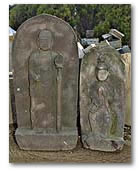 【 Image of Jizo Bosatsu (Ksitigarbha Bodhisattva)】
【 Image of Jizo Bosatsu (Ksitigarbha Bodhisattva)】
An image of Jizo Bosatsu stands by the past head priests' tombs in a corner of the graveyard. The image has not worn down or chipped so much because of the good quality of the stone used. It is boat-shaped (shaped like the bow of a boat viewed from above), measuring 85 centimeters or 2.79 feet high and 45 centimeters or 1.48 feet across. The engraved "seed-letter" ka remains clear and looks beautiful even after the long lapse of time. The inscription of date reading "March 19, Ninth year of Tenmei (1789), Year of Hinoe Uma (according to the Oriental zodiac calendar)" and the inscription of an posthumous Buddhist name reading "Hoin Eiyo" are both beautiful. The image of Jizo Bosatsu himself is carved in relief. Part of his staff with metal rings at the top is chipped off, but all the rest of the image has not worn down and looks beautiful. Especially the rich earlobes, the lines of the robe, and his gentle countenance have the seal of great compassion. It is really a good image.
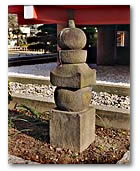 【Gorinto (Gravestone made up of five stone sections of different shapes and sizes)】
【Gorinto (Gravestone made up of five stone sections of different shapes and sizes)】
An old-looking gorinto stands among trees in a corner of the Temple's compound. It is about 92 centimeters or three feet high. The date engraved on the base stone reads "April 11, 13th year of Kanei" (1636). The posthumous Buddhist name reading "Doei Zenjomon" remains comparatively clear. According to the present head priest, this must be the name of a past head priest of the Temple.
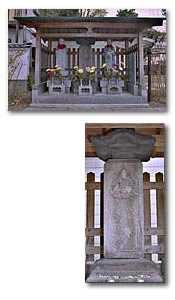 【Kasa-Toba (Tablet- or pillar-like gravestone with a cap)】
【Kasa-Toba (Tablet- or pillar-like gravestone with a cap)】
A stone gravestone with a cap (known as kasa-toba) is erected in a corner of the Temple's compound. It is a square pillar measuring 30 centimeters or about one foot long and wide and 95 centimeters or 3.12 feet high. Its pedestal is 55 centimeters or 1.8 feet wide, 70 centimeters or 2.3 feet long, and about 30 centimeters or one foot high. The cap is about 56 centimeters or 1.84 feet wide, about 31 centimeters or 1.02 feet long, and about 30 centimeters or one foot high. It is an irimoya-style roof with a Chinese-style gable in the front. A sparrow-shaped ornament is attached below the lower end at the center of the Chinese-style gable. The front face of the pillar is scooped out in the shape of a flower head, and the image of Kokuzo Bosatsu or Akasagarbha Bodhisattva (a bodhisattva whose wisdom and merit are as vast as the sky) is carved in relief therein. Below the image, there is an inscription meaning "Dedicated to the 13 Buddhas" on the right, and two lines of seven kanji characters meaning "13 thousand practices of sitting meditation completed" are engraved on the left. On the northern face of the pillar, there is a comparatively clear inscription of year reading "Second year of Tenwa, Year of Mizunoe Inu (according to the Oriental zodiac calendar). The "seed-letter" hrih is engraved in the upper part of the southern face of the pillar. Below this Sanskrit letter, three posthumous Buddhist names are engraved in three lines in each of the three parts on different levels of height. The names in the first part read "Shinyo Jun (one character illegible) Shinji," "Jihen Do (one character illegible) Shinji," and "Shuyo Kenan Shinji." The names in the second part read "(three characters illegible) Shun Shinji," "Shinyo Gyozen Shinji," and "Kado (one character illegible) Zen Shinnyo." The names in the third part read "(one character illegible) for Mother (two characters illegible)," "For (four characters illegible)," and "For (four characters illegible)." All the other characters here are illegible.
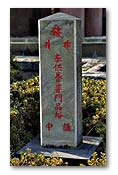 【Kuyo-to (Tower erected for the repose of deceased people)】
【Kuyo-to (Tower erected for the repose of deceased people)】
A small kuyo-to stands by the Main Hall. It is a square pillar measuring about 22 centimeters or 8.7 inches long, 17 centimeters or 6.7 inches wide, and 75 centimeters or 2.46 feet high. Amida and his two attendant bodhisattvas are carved in the upper part of the front face. Their carving is of excellent workmanship. The inscription of date reads "a Lucky Day of February, Seventh year of Bunka , Year of Kanoe Uma" (according to the Oriental zodiac calendar) (1810). The inscription of dedication reads "Fumon-bon Tower Dedicated by the Religious Fraternity" ("Fumon-bon" is the "Chapter on the Universal Gate" in the Sutra of the Law of the Wonderful Dharma). According to the Temple's legend, when the Temple was burnt down in the Bunka era (1804-1818), the followers and supporters made votive offerings of money for the reconstruction of the Temple and erected this Tower then. In addition to these stonework, the Temple has, among others, the following three images:
(1) Image of Kanzeon Bosatsu (another name of Kannon, Avalokitesvara Bodhisattva in Sanskrit) with an inscription of date reading "October 29, 15th year of Genroku" (1702).
(2) Image of Jizo Bosatsu (Ksitigarbha Bodhisattva) with an inscription of date reading "August 7, 19th year of Kyoho, Year of the Tiger" (1734).
(3) Image of Jizo Bosatsu (Ksitigarbha Bodhisattva) with an inscription of date reading "June 4, Fifth year of Hoei" (1708).
Before closing, we would like to thank Mr. Takanashi, a qualified specialist in the Japanese important cultural properties, for his leading role in this research, and Rev. Nakajima Seijun of Zuiho-ji for his assistance in various aspects.
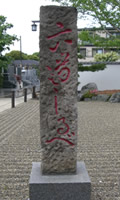 【Rokudou-shirube】
【Rokudou-shirube】
